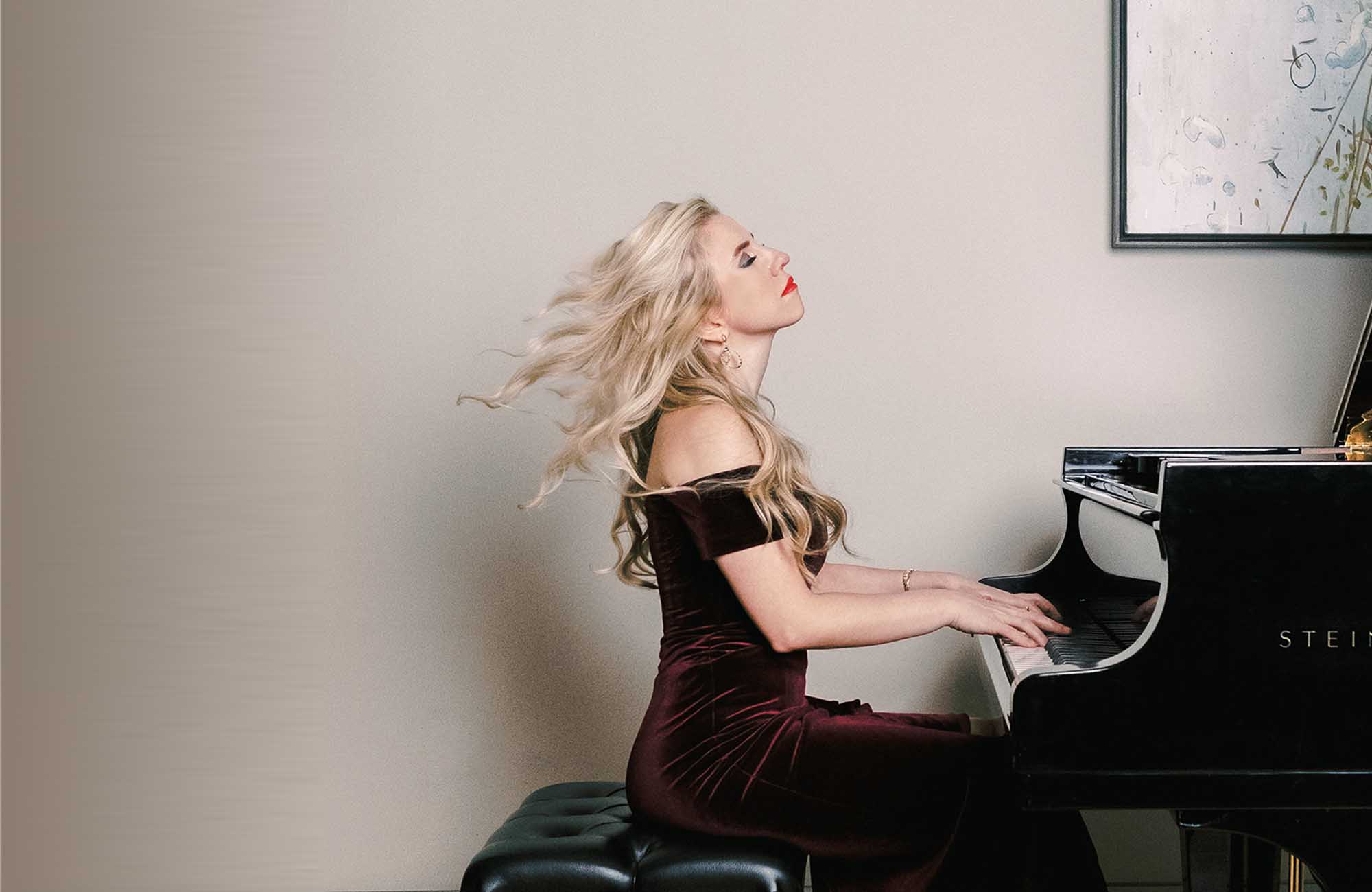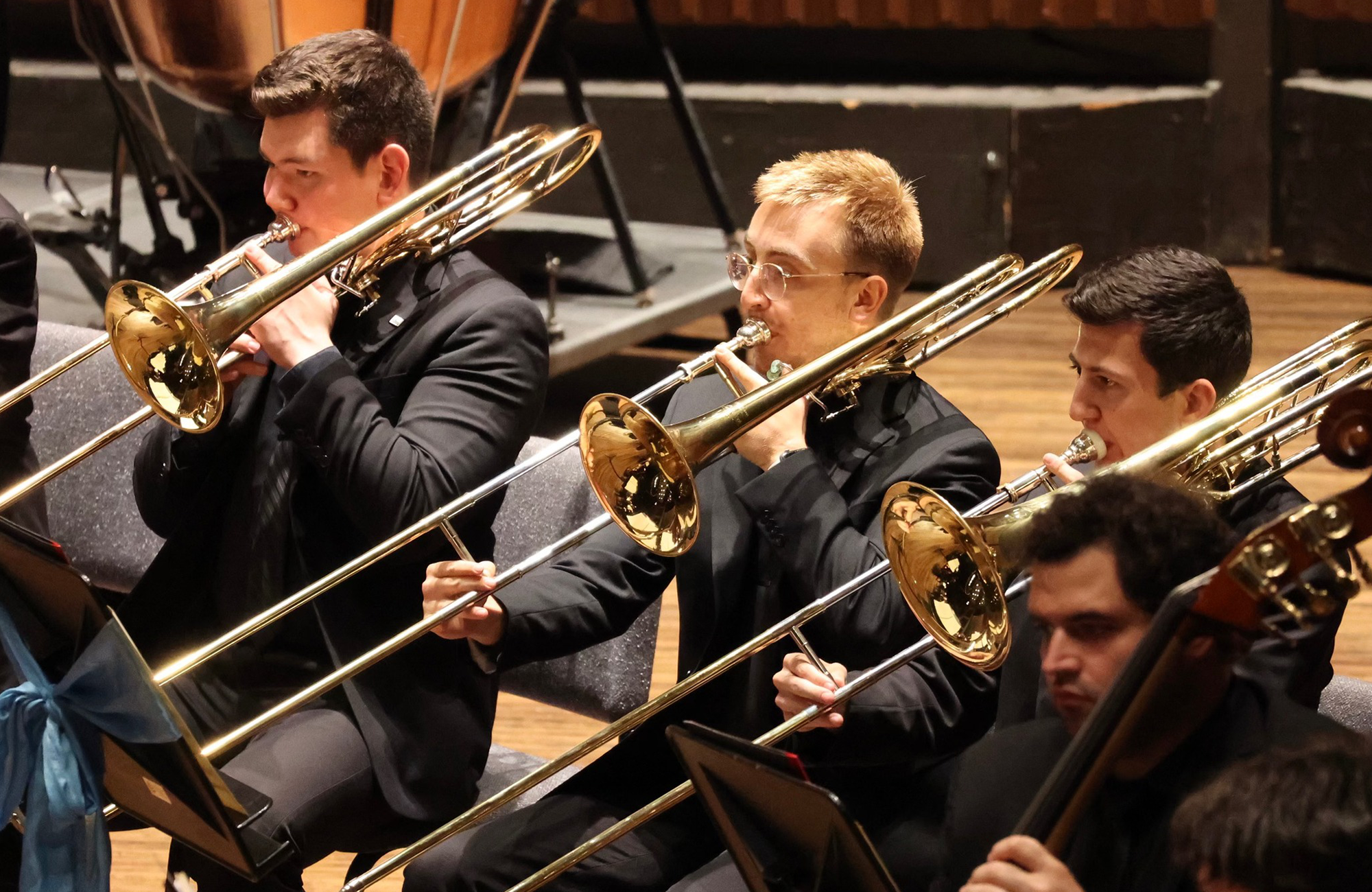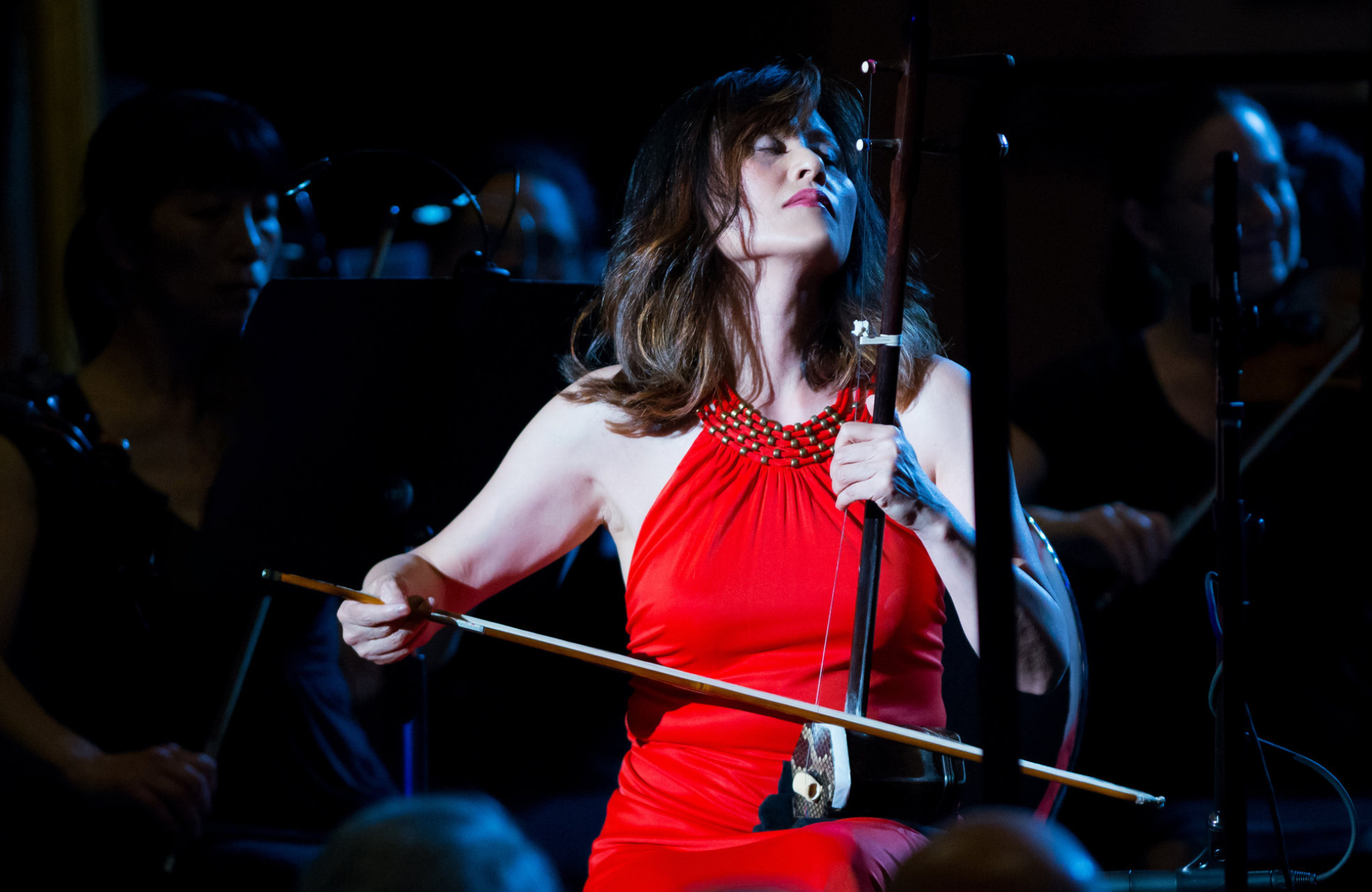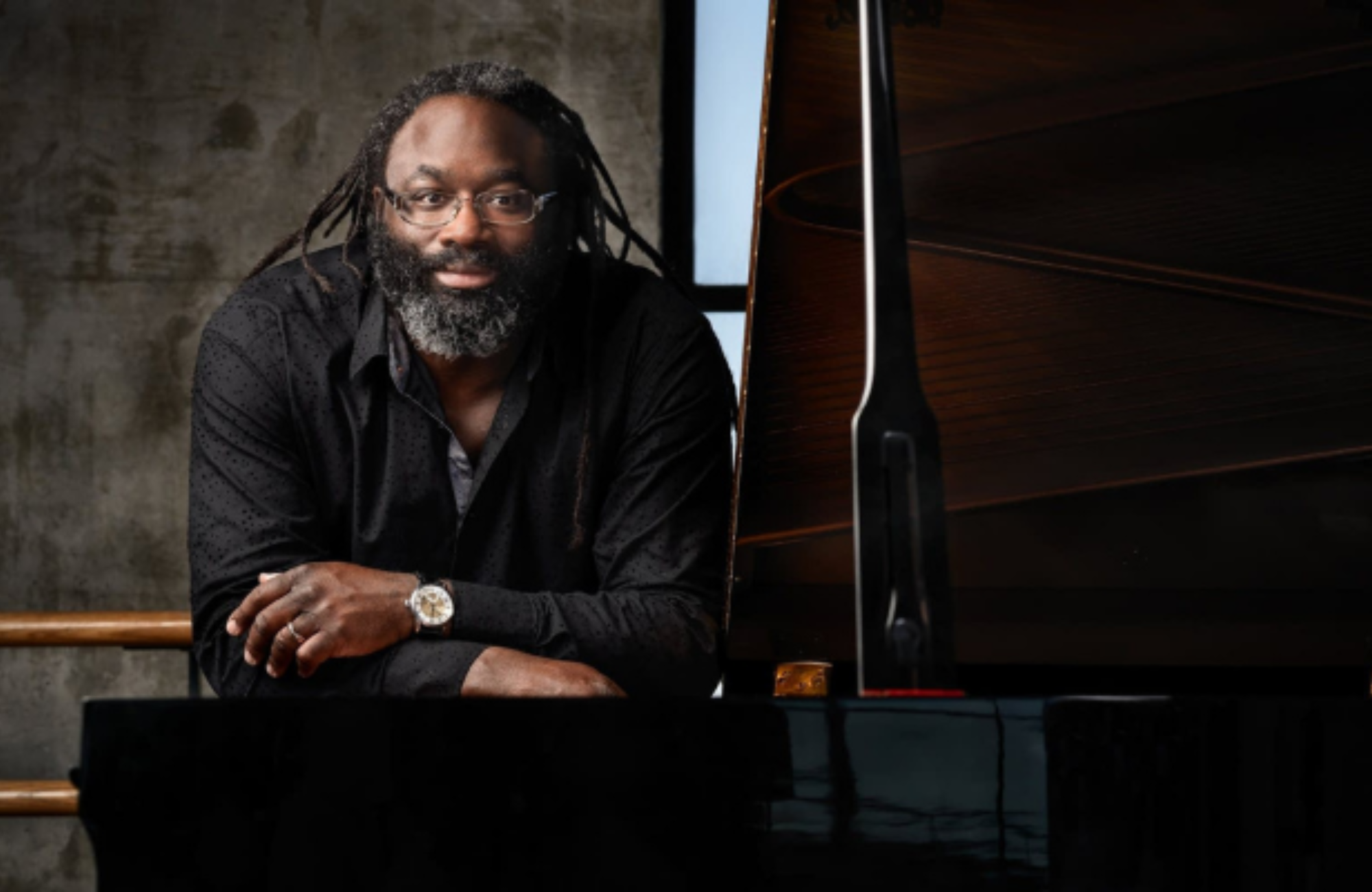In an act of daring most pianists would never even consider, Natasha Paremski will perform all four of Rachmaninoff’s beautiful and technically challenging piano concertos in two back-to-back nights! This is a once-in-a-lifetime opportunity right here in Syracuse, to witness the range and depth, not only of Rachmaninoff’s masterpieces, but also Paremski’s daring musical feat. The sheer romantic beauty of the music will be the cherry on top. Don’t miss either one of these concerts!
PROGRAM
RACHMANINOFF: Scherzo in D minor ![]()
RACHMANINOFF: Concerto, Piano, No.1, op.1, F-sharp minor ![]()
RACHMANINOFF: Concerto, Piano, No.3, op.30, D minor ![]()
Thanks to our generous sponsor!
![]()
PROGRAM NOTES
Symphoria is committed to trying new things while still bringing you the mainstays of the repertoire—and this weekend, we fulfill both aims, honoring a beloved composer, Sergei Rachmaninoff (1873–1943), with a festival of back-to-back concerts (something we’ve never done before) that deepen appreciation of his output.
Each concert begins with an appetizer. Friday’s opener is a rarity, one of his earliest works, the fleet-footed, lightly scored Scherzo in D minor (1888). It seems modelled on the scherzo from Mendelssohn’s Midsummer Night’s Dream—a work for which Rachmaninoff had an abiding affection (he made a ...
Symphoria is committed to trying new things while still bringing you the mainstays of the repertoire—and this weekend, we fulfill both aims, honoring a beloved composer, Sergei Rachmaninoff (1873–1943), with a festival of back-to-back concerts (something we’ve never done before) that deepen appreciation of his output.
Each concert begins with an appetizer. Friday’s opener is a rarity, one of his earliest works, the fleet-footed, lightly scored Scherzo in D minor (1888). It seems modelled on the scherzo from Mendelssohn’s Midsummer Night’s Dream—a work for which Rachmaninoff had an abiding affection (he made a piano transcription in 1933). Saturday’s concert, in contrast, begins with one of Rachmaninoff’s most enduring works—the haunting Vocalise (1915). A vocalise is a song without words, and this one originally rounded out a collection of linguistically rich settings of Russia’s greatest poets. A suggestion that music can take us to a realm beyond the power of words? Perhaps. In any case, Rachmaninoff adapted it for voice and orchestra and for orchestra alone (the version we’re hearing)—and it’s since been arranged for virtually every instrument around.
The meat of the festival, though, consists of Rachmaninoff’s four piano concertos. This set of works has a curious status. On the one hand, it’s the premiere romantic piano concerto cycle after Beethoven’s, both the most popular and the most consistently high in quality—at least if we consider the term “cycle” to mean more than the one or two concertos penned by composers like Grieg and Liszt. On the other hand, its fame rests largely on the two concertos in the center; the First and Fourth are less familiar. One goal of the festival is to redress that imbalance by showing how well the two outliers hold up.
But there are three other goals as well. One is to celebrate the sheer quality of Rachmaninoff’s output. Although he has always been popular with listeners, he was for many years, like his idol Tchaikovsky, disdained by critics, especially those caught up in the modernist dogmas that Rachmaninoff resisted. It was also often assumed that because his music is so immediate in its emotional appeal, it must be cheap. It’s only recently that the depth and consistency of the craft of his music has been appreciated, and that critics have come to recognize that his romantic effusion is tied to a perfectionism few others can match.
Then, too, we hope that this weekend will give you a renewed appreciation of the range of his work. Even some of his most ardent admirers circulate the cliché that his music all sounds alike. Not so, said tonight’s soloist Natasha Paremsky when we talked last July: “The fun part about this cycle is that you’re actually experiencing all these different sides of this composer. There are so many flavors and so many experiences.”
As for the final goal: for all his meticulousness, Rachmaninoff was a virtuoso pianist; many would say he was the greatest who ever made recordings. There’s also, therefore, an acrobatic side to his art as well. The Third has often been called “the Everest of piano concertos”—but in fact, any of his concertos offers a chance for a pianist to show off her technique, and performing all four in a weekend, if not unprecedented, is a courageous feat. Natasha is nothing if not courageous: when she was invited, by text, to take on this challenge, it took her about 40 seconds to accept—even though that meant committing herself to learning the Fourth, which she had never performed before. “I have been wanting to do this for such a long time, because Rachmaninoff is so special to me.”
The Piano Concerto No. 1, originally composed in 1891 when the composer was still in his teens, is a fledgling piece—sufficiently so that Rachmaninoff revised it substantially in 1917 (that’s the version we’ll be hearing on Friday). “I feel,” says Natasha, “like the First is by a young man who is influenced by Grieg and his surroundings, like Glazunov, Anton Rubinstein, and Tchaikovsky. It’s innocent in so many ways.” And yet (especially in the revised version), “it does echo what is to come in the Fourth. There’s a lot of jazz in the second and third movements.” One notable feature is the huge first movement cadenza—an obvious opportunity for display that the composer was giving to himself as a pianist.
The Piano Concerto No. 2, from 1901, is radically different in both style and meaning. It came in the wake of a crushing experience. In 1897, Glazunov conducted the premiere of Rachmaninoff’s First Symphony—and the performance was a disaster, puzzling the audience and drawing contempt from the critics. Was Glazunov drunk at the time? Was the music too original? In any case, Rachmaninoff, in what Natasha calls “a deep depression,” withdrew the piece (it was fortuitously rediscovered years later) and virtually abandoned composition in favor of conducting and piano playing. Fortunately, meetings with hypno-therapist Nikolai Dahl lifted his gloom and convinced him to take up the pen again. One immediate consequence was the Second Concerto, dedicated to Dahl.
It’s therefore what Natasha calls “a survival piece,” one that announces, “I survived a really horrific time and I came out of it.” Indeed, it expresses not only survival, but self-confidence, too. “It’s almost like a middle finger” to the establishment, in which Rachmaninoff says, “‘I’m absolutely a great composer, you know! No ifs, ands or buts.’” It’s also one of those rare works that has been consistently popular from its premiere. In part, that’s because of its rich harmonies. In part, that’s because of luscious, singable melodies that took on a life as pop songs (Eric Carmen’s “All By Myself” was a recasting of Rachmaninoff’s second movement and “Full Moon and Empty Eyes,” popularized by Frank Sinatra, was drawn from the third). In part, that’s because of the assurance of the piano and orchestral writing. In any case, says Natasha, works like the Grieg “go in and out of style; Rach II never goes out of style.”
For Natasha, the Second is the greatest in the cycle, “the crown jewel.” And although she’s played it often, it remains consistently new. “The more experience I have in life, the more I see life experience reflected in the expressive genius of the Second, and the more I can connect to it in a fresh way.”
Even so, she actually likes the Piano Concerto No. 3 even more. Written in Dresden and first presented in New York (Mahler conducted the second performance), it’s now as popular as the Second; but it moved more slowly into the repertoire. For decades, only a few pianists would dream of programming it; even its dedicatee Josef Hofmann, one of the few competitors to Rachmaninoff’s status as the greatest pianist alive, never performed it. Why? Technically, Natasha says, it’s “the most difficult concerto in the repertoire. It’s Rachmaninoff saying ‘Check this out. Nobody’s ever done this before!’” As a result, while it’s her favorite, it’s got “a sprinkle of fear on top. That’s okay. It’s all right to be trepidatious in the face of genius. It keeps you humble.” Rachmaninoff wrote two different cadenzas: Natasha, not surprisingly. will play the larger of the two.
For all its difficulty, the Third has other important qualities as well. Compared to the Second, says Natasha, it “comes from a completely different place. It’s jazzier, more improvisatory, and denser, yet it’s based in a tighter kernel. He takes these leitmotifs and expands on them in an unbelievable way. It’s also crazier, a mind labyrinth. Your brain is just like ‘wow’! In its treatment of the inner notes, it’s like a Bach concerto on steroids. It breaks all the boundaries of what’s possible in expression on the piano.”
The 1926 Piano Concerto No. 4 is, again, something completely different. If the First is marked by innocence, the Second by survival, and the Third by boundary-breaking, the Fourth—the only one written after Rachmaninoff’s emigration to America—is influenced, far more than the Third, by New York jazz. The interest in virtuosity that marked the Third has been muted, and something more typically American has taken its place.
Natasha elaborates on the differences: “The Third is like body-building, high intensity integral training, and weight-lifting all combined into one explosive package, complete with harmonic modulations that will make anybody’s head spin. Rach IV is not quite the same pianistic challenge, the same flexing the biceps. Still, there’s a lot of harmonic modulation that makes many pianists shy away. It’s got very complicated, non-stop sequences.” She describes the style with an appropriately New York City metaphor: “We’re going from 90th and Amsterdam to 100th and Amsterdam, but we’re going to take a plane and go to New Zealand and Singapore, and still end up at 100th and Amsterdam. He could’ve just gotten us there in a straight line, but he goes through several different countries and cultures to get ten blocks. It’s almost comical.”
Comical? Stravinsky once described Rachmaninoff as a “six-and-a-half-foot scowl,” but you wouldn’t think so listening to the Fourth, Rachmaninoff’s wittiest concerto. As with the First, Rachmaninoff had second thoughts, revising it several times. Again, we’ll be hearing the composer’s final version.
For Natasha, this weekend is a major event. “Rachmaninoff got me through some dark times. I feel we’re friends. I feel honored to be able to do this.” She’s especially pleased to be working with conductor Larry Loh. As Larry points out, the Rachmaninoff Concertos have a complex integration of soloist and orchestra—it’s an immersive experience, not simply a case of having the piano “out in front” with the orchestra as a backdrop. And for Natasha, Larry is “the best person I could ever think of” for this kind of interaction. “Every time I walk on stage with Larry, I feel at ease. I have my friend right there, who can do whatever, and we play off each other. It’s super easy, and fun.”
We hope it will be a major event—and fun—for you, too.
Peter J. Rabinowitz
Have comments or questions? Contact me at prabinowitz@ExperienceSymphoria.org
FEATURED ARTISTS
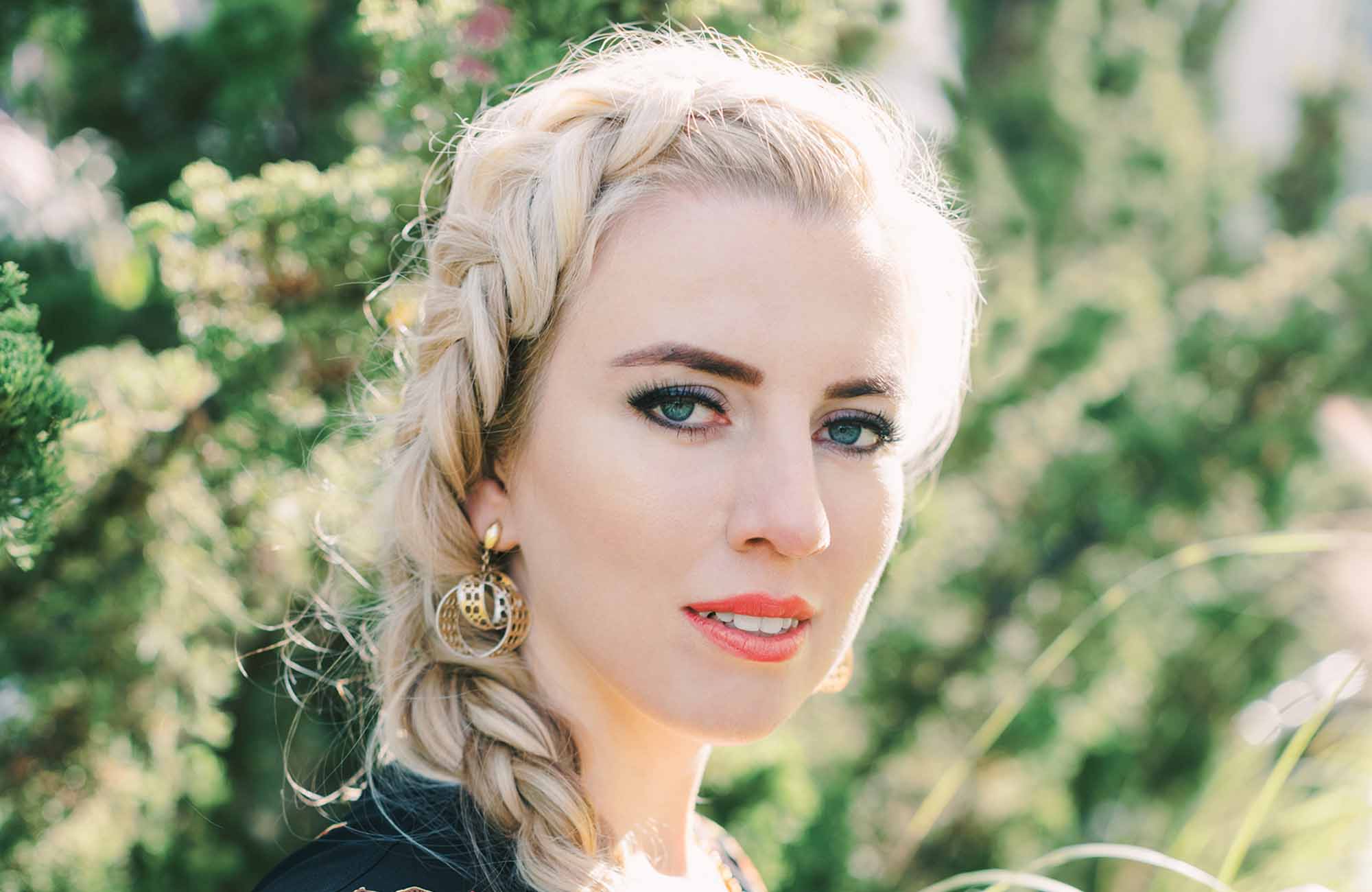
With her consistently striking and dynamic performances, pianist Natasha Paremski reveals astounding virtuosity and voracious interpretive abilities. She continues to generate excitement from all corners as she wins over audiences with her musical sensibility and powerful, flawless technique.
The 2018-19 season featured recitals in New York and ...
With her consistently striking and dynamic performances, pianist Natasha Paremski reveals astounding virtuosity and voracious interpretive abilities. She continues to generate excitement from all corners as she wins over audiences with her musical sensibility and powerful, flawless technique.
The 2018-19 season featured recitals in New York and Chicago in addition to concerto appearances in North America, Europe and South America. Her recording of Fred Hersch’s Variations on a Theme by Tchaikovsky – commissioned for her by the Gilmore Festival – was released in early 2019 on the Steinway & Sons label alongside Mussorgsky’s Pictures at an Exhibition. In 2019-20 she performs the Rachmaninoff cycle with Symphoria Syracuse, returns to Columbus Symphony, and will perform with the Knoxville, Jacksonville and Charleston Symphonies. She will also give a recital at Herbst Hall in San Francisco.
Natasha is a regular return guest of many major orchestras, including Minnesota Orchestra, San Francisco Symphony, Grant Park Festival, Winnipeg Symphony, Kitchener-Waterloo Symphony, Oregon Symphony, Elgin Symphony, Colorado Symphony, Buffalo Philharmonic, Virginia Symphony, and Royal Philharmonic Orchestra with whom she has performed every year since 2008 in venues such as Royal Albert Hall, Royal Festival Hall, and Cadogan Hall. She has performed with major orchestras in North America including Dallas Symphony Orchestra, Los Angeles Philharmonic Orchestra, San Diego Symphony, Toronto Symphony, Baltimore Symphony, Houston Symphony, NAC Orchestra in Ottawa, Nashville Symphony. She has toured extensively in Europe with such orchestras as Bournemouth Symphony Orchestra, Vienna’s Tonkünstler Orchester, Royal Scottish National Orchestra, Orchestre de Bretagne, the Orchestre de Nancy, Royal Liverpool Philharmonic Orchestra, Tonhalle Orchester in Zurich, Moscow Philharmonic, under the direction of conductors including Thomas Dausgaard, Peter Oundjian, Andres Orozco-Estrada, Jeffrey Kahane, James Gaffigan, JoAnn Falletta, Fabien Gabel, Rossen Milanov and Andrew Litton. In addition, she has toured with Gidon Kremer and the Kremerata Baltica in Latvia, Benelux, the United Kingdom and Austria as well as appearances with National Taiwan Symphony Orchestra in Taipei.
Natasha has given recitals at the Auditorium du Louvre in Paris, Wigmore Hall, Schloss Elmau, Mecklenburg-Vorpommern Festival, Verbier Festival, Seattle’s Meany Hall, Kansas City’s Harriman Jewell Series, Santa Fe’s Lensic Theater, Ludwigshafen BASF Series, Teatro Colon in Buenos Aires, Tokyo’s Musashino Performing Arts Center and on the Rising Stars Series of Gilmore and Ravinia Festivals.
A passionate chamber musician, Natasha is a regular recital partner of Grammy winning cellist Zuill Bailey, with whom she has recorded a number of CDs. Their Britten album on Telarc debuted at No. 1 on the Billboard Classical Chart, remaining there for a number of weeks, in addition to being featured on The New York Times Playlist. She has been a guest of many chamber music festivals such as Jeffrey Kahane’s Green Music Center ChamberFest, the Lockenhaus, Toronto, Sitka Summer Music, and Cape Cod Chamber Music festivals to name a few.
Natasha was awarded several prestigious prizes at a very young age, including the Gilmore Young Artists prize in 2006 at the age of eighteen, the Prix Montblanc in 2007, the Orpheum Stiftung Prize in Switzerland. In September 2010, she was awarded the Classical Recording Foundation’s Young Artist of the Year. Her first recital album was released in 2011 to great acclaim, topping the Billboard Classical Charts, and was re-released on the Steinway & Sons label in September 2016 featuring Islamey, recorded on Steinway’s revolutionary new Spirio technology. In 2012 she recorded Tchaikovsky’s Piano Concerto No. 1 and Rachmaninoff’s Paganini Rhapsody with Royal Philharmonic Orchestra and Fabien Gabel on the orchestra’s label distributed by Naxos.
With a strong focus on new music, Natasha’s growing repertoire reflects an artistic maturity beyond her years. In the 2010-11 season, she played the world premiere of a sonata written for her by Gabriel Kahane, which was also included in her solo album.
Natasha continues to extend her performance activity and range beyond the traditional concert hall. In December 2008, she was the featured pianist in choreographer Benjamin Millepied’s Danses Concertantes at New York’s Joyce Theater. She was featured in a major two-part film for BBC Television on the life and work of Tchaikovsky, shot on location in St. Petersburg, performing excerpts from Tchaikovsky’s First Piano Concerto and other works. In the winter of 2007, Natasha participated along with Simon Keenlyside in the filming of Twin Spirits, a project starring Sting and Trudie Styler that explores the music and writing of Robert and Clara Schumann, which was released on DVD. She has performed in the project live several times with the co-creators in New York and the U.K., directed by John Caird, the original director/adaptor of the musical Les Misérables.
Natasha began her piano studies at the age of four with Nina Malikova at Moscow’s Andreyev School of Music. She then studied at San Francisco Conservatory of Music before moving to New York to study with Pavlina Dokovska at Mannes College of Music, from which she graduated in 2007. Natasha made her professional debut at age nine with El Camino Youth Symphony in California. At the age of fifteen she debuted with Los Angeles Philharmonic and recorded two discs with Moscow Philharmonic Orchestra.
Born in Moscow, Natasha moved to the United States at the age of eight becoming a U.S. citizen shortly thereafter, and is now based in New York.

Described as bringing an “artisan storyteller’s sensitivity… shaping passages with clarity and power via beautifully sculpted dynamics… revealing orchestral character not seen or heard before” (Arts Knoxville) Lawrence Loh enjoys a dynamic career as a conductor of orchestras all over the world.
After an extensive two ...
Described as bringing an “artisan storyteller’s sensitivity… shaping passages with clarity and power via beautifully sculpted dynamics… revealing orchestral character not seen or heard before” (Arts Knoxville) Lawrence Loh enjoys a dynamic career as a conductor of orchestras all over the world.
After an extensive two year search, Lawrence Loh was recently named Music Director of the Waco Symphony Orchestra beginning in the Spring of 2024. Since 2015, he has served as Music Director of The Syracuse Orchestra (formerly called Symphoria), the successor to the Syracuse Symphony Orchestra. “The connection between the organization and its audience is one of the qualities that’s come to define Syracuse’s symphony as it wraps up its 10th season, a milestone that might have seemed impossible at the beginning,” (Syracuse.com) The Syracuse Orchestra and Lawrence Loh show that it is possible to create a “new, more sustainable artistic institution from the ground up.”
Appointed Assistant Conductor of the Pittsburgh Symphony in 2005, Mr Loh was quickly promoted to Associate and Resident Conductor within the first three years of working with the PSO. Always a favorite among Pittsburgh audiences, Loh returns frequently to his adopted city to conduct the PSO in a variety of concerts. Mr. Loh previously served as Music Director of the West Virginia Symphony Orchestra, Music Director of the Northeastern Pennsylvania Philharmonic, Artistic Director and Principal Conductor of the Syracuse Opera, Music Director of the Pittsburgh Youth Symphony Orchestra, Associate Conductor of the Dallas Symphony Orchestra, Associate Conductor of the Colorado Symphony Orchestra and Music Director of the Denver Young Artists Orchestra.
Mr. Loh’s recent guest conducting engagements include the San Francisco Symphony, Dallas Symphony, North Carolina Symphony, Baltimore Symphony, Sarasota Orchestra, Florida Orchestra, Pensacola Symphony, Atlanta Symphony, National Symphony, Detroit Symphony, San Diego Symphony, Seattle Symphony, National Symphony (D.C.), Utah Symphony, Rochester Philharmonic, Indianapolis Symphony, Calgary Philharmonic, Buffalo Philharmonic, Albany Symphony and the Cathedral Choral Society at the Washington National Cathedral. His summer appearances include the festivals of Grant Park, Boston University Tanglewood Institute, Tanglewood with the Boston Pops, Chautauqua, Sun Valley, Shippensburg, Bravo Vail Valley, the Kinhaven Music School and the Performing Arts Institute (PA).
As a self-described “Star Wars geek” and film music enthusiast, Loh has conducted numerous sold-out John Williams and film music tribute concerts. Part of his appeal is his ability to serve as both host and conductor. “It is his enthusiasm for Williams’ music and the films for which it was written that is Loh’s great strength in this program. A fan’s enthusiasm drives his performances in broad strokes and details and fills his speaking to the audience with irresistible appeal. He used no cue cards. One felt he could speak at filibuster length on Williams’ music.” (Pittsburgh Tribune)
Mr Loh has assisted John Williams on multiple occasions and has worked with a wide range of pops artists from Chris Botti and Ann Hampton Callaway to Jason Alexander and Idina Menzel. As one of the most requested conductors for conducting Films in Concert, Loh has led Black Panther, Star Wars (Episodes 4-6), Jaws, Nightmare Before Christmas, Jurassic Park, Casablanca, The Wizard of Oz and Singin’ in the Rain, among other film productions.
Lawrence Loh received his Artist Diploma in Orchestral Conducting from Yale, his Masters in Choral Conducting from Indiana University and his Bachelor of Arts from the University of Rochester. Lawrence Loh was born in southern California of Korean parentage and raised in Carlisle, Pennsylvania. He and his wife Jennifer have a son, Charlie, and a daughter, Hilary. Follow him on instagram @conductorlarryloh or Facebook at @lawrencelohconductor or visit his website, www.lawrenceloh.com


